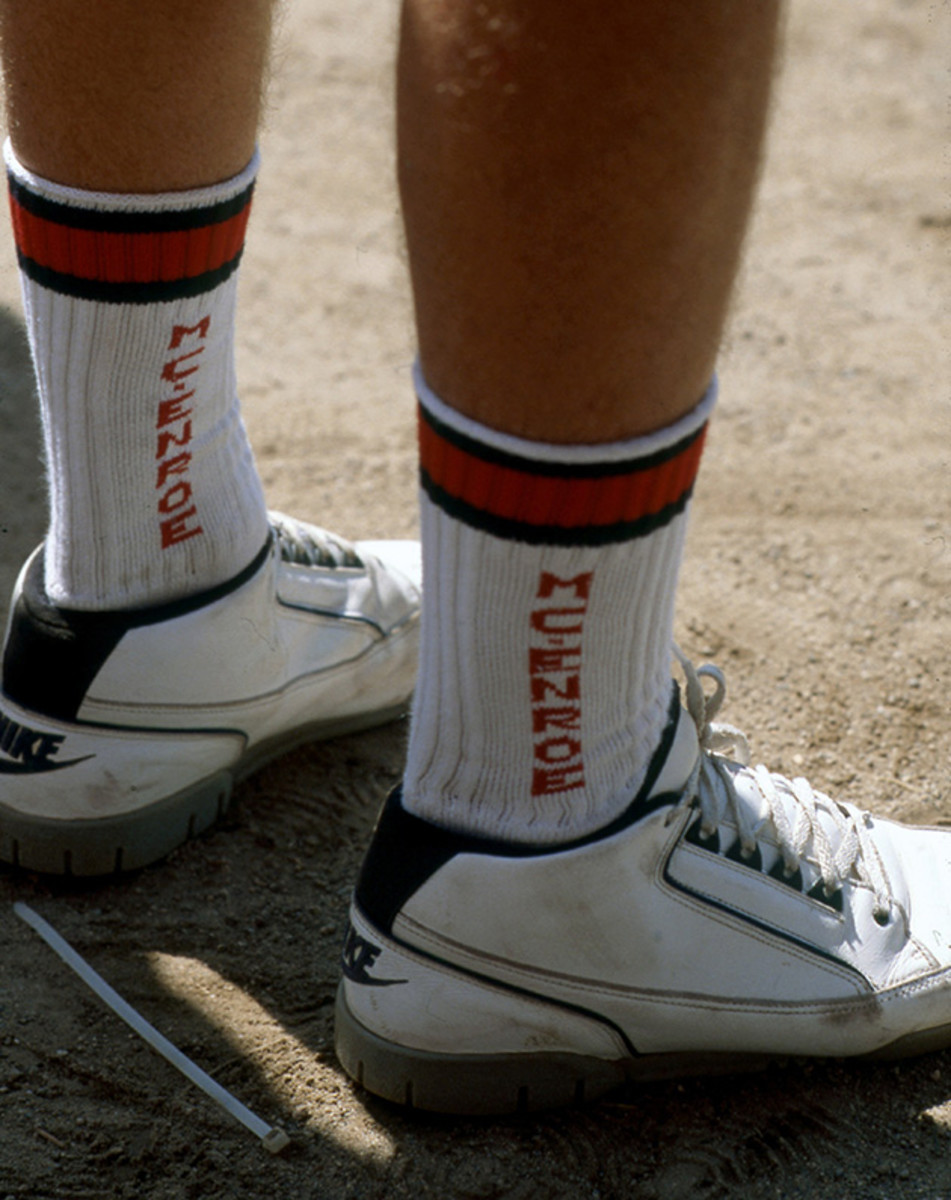The evolution of tennis shoes: From plimsolls to Stan Smiths and Nikes

This story is one segment of a four-part series on SI Tennis that will look back in history and chronicle the changes and progression of fundamental aspects of the game, from sneakers to rackets and more.
Rubber and canvas combinations dominated the feet of tennis players for decades. But Stan Smith helped usher in a whole new wave of high-tech shoes when he got behind an Adidas shoe that featured leather. Yes, leather, a massive change in the late 1960s and early 1970s that spawned a new way of thinking about tennis shoes.
“It was the only leather shoe (on the tennis courts),” says Smith, a two-time Grand Slam singles champion and namesake to the most popular tennis sneaker of all time. “It was considered kind of high-tech at the time (compared to) the canvas shoe. It had pretty good support; it was considered an upgrade from the other shoes.”
But the story of the legendary Adidas Stan Smith shoe goes beyond its lead endorser and the history of the tennis shoe as a whole dips much further into the past than Smith.
The early years
The plimsoll shoe—a rubber outsole with a canvas upper—has graced tennis courts ever since the 1800s. In 1839, Charles Goodyear began to develop vulcanized rubber, a chemically-altered version of rubber that is more stable and more resistant to heat. Other companies followed suit and soon the vulcanized rubber was being combined with canvas to create the first foray into athletic shoes.
Various options of shoes started to take off in the early 1900s. The United States Rubber Company (later Uniroyal) introduced Keds in 1916, the first popular shoe used in tennis. Converse hit the market in 1917 with the All-Star. Adidas marketed the first shoe specifically for tennis in 1931.
The history of natural gut strings and why they're still used in tennis today
Signature style started to take form by 1935 when badminton player Jack Purcell created a shoe for the B.F. Goodrich Company of Canada, which easily made its way to the tennis courts (Converse bought the rights to the Jack Purcell signature model in the 1970s).
Canvas and rubber combinations started in the 1800s and remained the norm well into the 1960s and beyond, as plenty of companies created popular shoes, such as the Dunlop Green Flash and the Dunlop Volley that gained immense popularity in Australia.
Smith says he remembers most players in the ‘60s wearing either Converse or the Jack Purcells. “There wasn’t a big choice,” he says. “I don't remember people thinking about shoes too much.”
That would change.
Robert Haillet to Stan Smith
Adidas wanted to do something a little different in the 1960s. The sport already had canvas and rubber, but Adidas ushered in a first on the tennis court. Adidas added leather, getting Frenchman Robert Haillet to endorse the new shoe in 1964. But a few years after putting Haillet’s face on the tongue of this leather construction, the French star retired and Adidas needed a new endorser. They turned to American Stan Smith who became the face of the Haillet shoe in 1971.
Prior to Adidas approaching Smith, he was still wearing a shoe made by Uniroyal (now owned by Michelin), a rubber and tire company, and had tried the Dunlop Volley once in Australia based a recommendation. But he couldn't pass up the endorsement opportunity and made the switch to the leather Haillet.

“Well, it was interesting,” he says. “It was the only shoe out there at the time (with leather) and it already had a bit of a following and was fairly unique in tennis. It took a little bit of time (to get used to it), but it was pretty comfortable.”
Smith wore the shoe when he won his two Grand Slam singles titles and eventually Haillet’s name and likeness evolved off the shoe, making way for Smith to completely take over. And while the construction of the shoe didn’t change much, Smith says he did suggest more protection around the Achilles—hence the addition of the green padding on the back of the shoe—and a tongue that didn’t shift.
In the 1970s, Adidas had the Stan Smith, the Rod Laver and the Ilie Nastase shoes. And since, as Smith tells it, the three stripes on the Adidas products were designed for additional support. (The Smith and Laver shoes didn’t feature the three stripes as we know it today.)
“One time we played on clay and (Laver) put a pair of my shoes on,” Smith says of the trio of athletes. “They played better on clay with the rubber nubs than the polyurethane bottom he had on his shoes. I took some photographs of that, of him wearing my shoe.”
While the Stan Smith introduced leather, other companies quickly followed suit. And the material evolution was on.
A modern shift
From the change in materials in the Adidas Stan Smith shoes, other brands also made a switch. The K Swiss Classic added leather, followed by the Puma Match and the Nike Wimbledon—worn by John McEnroe—in the late 1970s and early 1980s.
As more companies embraced leather, other materials entered the fray. In 1970, Adidas launched the Rod Laver signature with a polyurethane outsole, suede on the toe and a mesh upper, a major shift into new materials. Construction kept changing in the 1980s and McEnroe was partially to credit for the shift. As Nike grew in popularity, shoe designer Tinker Hatfield designed the Nike Air Trainer 1 with lateral support, a foot-securing strap for side-to-side movement and a heel lift that was higher than a typical court shoe, but lower than a traditional running shoe. This trainer, though, hit tennis before it hit the workout rooms. In 1986, before the consumer launch in 1987, McEnroe asked Nike for something more modern upon his return to tennis.

“By chance, when the guys at Nike sent me a bunch of different prototypes to try, there was this throwaway one that they weren’t even planning on sending me,” McEnroe says. “And it turned out being the one to me that was the most awesome.” Nike had sent the trainer in the batch and once Hatfield found out he asked McEnroe not to wear them in tournaments. “Once they were on, I was like, ‘Sorry guys this is the one. We have to go with this, we have to reverse field here.’ This one felt really right,” McEnroe says.
Hatfield says McEnroe wasn’t supposed to wear the shoes, so when he saw him donning them in a tournament it was a “jaw-dropping experience.” But McEnroe started winning in the shoes and Nike gave in and sent him specific outsole versions for both grass and clay. “It gave the support I needed because I had some difficulty with ankle sprains,” McEnroe says, “and it gave me the jump I needed on the court.”
By the mid-90s Nike had branched out its tennis offerings, outfitting Pete Sampras in the Air Oscillate and Andre Agassi in the Air Tech Challenge III, both designed by Hatfield.
“It is a shoe I can still wear,” Sampras says. “My whole career, it fit my foot. It did everything I wanted it to be.”
The history of tennis umpiring: How Hawk-Eye changed the game
Sampras says he “took a chance” on the shoe, as Hatfield had to trick him into putting it on originally by inviting him to play basketball and telling him it was a basketball shoe. But the trick paid off for the 14-time Grand Slam singles champion.
Nike wasn’t the only company going high-tech by the '90s, as New Balance, Puma, Converse (with signature Jimmy Connors shoes), Adidas (with new shoes for Ivan Lendl and Stefan Edberg), Wilson, Diadora, K Swiss, Lotto and Fila had all entered the tennis shoe realm by mixing materials and construction.
The introduction of leather in the 1960s set a new technically-focused trajectory for tennis shoes, one with a history still carved out of canvas and rubber.
Tim Newcomb covers stadiums, sneakers and technology for Sports Illustrated. Follow him on Twitter at @tdnewcomb.
